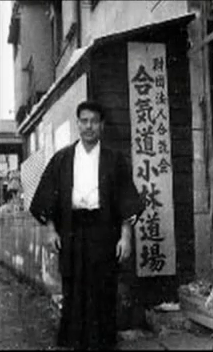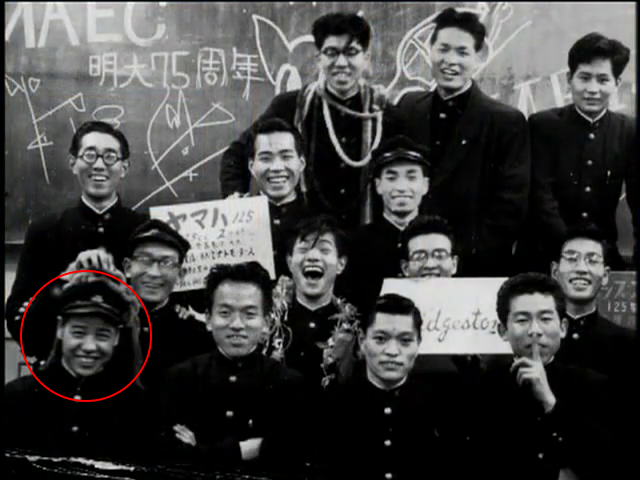 Yasuo Kobayashi in Hawaii in 2008
Yasuo Kobayashi in Hawaii in 2008
the late Robert Kubo – Aikikai 8th Dan, Aikido Hawaii International, on the left
“At that point in time, I was caught up in some of the political nonsense amongst various teachers residing in the States, and held forth on this one drunken night at one of the regular parties the dojo had, and Kobayashi sensei said, “X-sensei is my friend, Y-sensei is my friend, Z-sensei is my friend. It all seems simple to me.” In his happy air, in his unpretentious practice and refusal to mystify aikido as either the ultimate combat or a means of establishing world peace, it would have been easy to regard him as an unexceptional man, one who simply liked pleasure, be it jovial laughter, enough beers to make him wobble when he bicycled home, and a regular routine of thumping his students and being thumped in turn. Rather, he always seemed to me to be a man of sublime common sense. As theoretical physicists strive for elegance and simplicity in their equations, Kobayashi sensei appeared to me to do with his life. Such simplicity is far from easy, and all too rare.”
It Had to Be Felt #30: Kobayashi Yasuo – A Living Axle, by Ellis Amdur
Yasuo Kobayashi was born in Tokyo in 1936 and started training in Judo in his fifth year of elementary school. He enrolled at Aikido Hombu Dojo in 1954, the same year that he entered Meiji University, becoming one of the early post-war students of Aikido Founder Morihei Ueshiba. Now an eighth dan, he is the head of Aikido Kobayashi Dojo, which has more than 120 affiliated dojo around the world
A round table discussion with Kobayashi Sensei appeared previously on the Aikido Sangenkai blog as “Yasuo Kobayashi and Fumiko Nakayama – Living Aikido” (Part 1 | Part 2 | Part 3).
The current interview is the second part of a two part interview with Kobayashi Sensei that originally appeared in the May 2005 issue of Gekkan Hiden (月刊秘伝 / “Secret Teachings Monthly”), a well known martial arts magazine in Japan. You may wish to read Part 1 of the interview before reading this section.
This interview was also published in a collection of interviews with students of the Founder published in Japanese as 開祖の横顔 (“Profiles of the Founder”) in 2009. There was a short introduction to this work in the article “Morihei Ueshiba – Profiles of the Founder“. A number of English translations of interviews from that collection appeared have appeared previously – Nobuyoshi Tamura Sensei (Part 1 | Part 2), Hiroshi Isoyama Sensei (Part 1 | Part 2), Shigenobu Okumura Sensei (Part 1 | Part 2), Nobuyuki Watanabe Sensei (Part 1 | Part 2), Masatake Fujita Sensei (Part 1 | Part 2) , Yoshimitsu Yamada Sensei (Part 1 | Part 2), Kanshu Sunadomari Sensei (Part 1 | Part 2), Hiroshi Kato Sensei (Part 1 | Part 2), Yoshio Kuroiwa Sensei (Part 1 | Part 2), Morito Suganuma (Part 1 | Part 2) and Kenji Shimizu (Part 1 | Part 2).
 “However hard we pushed the staff would not move.” – Yasuo Kobayashi
“However hard we pushed the staff would not move.” – Yasuo Kobayashi
Interview with Aikido Shihan Yasuo Kobayashi – Part 2
Q: I see. Do the jiyu-waza (“freee-style techniques”) that are often seen at demonstrations date from that time?
A: No, that began to be done after a system of examinations was established. After the number of members began to increase a system of Dan and Kyu examinations was established, and the uchi-deshi took ukemi at the time. However, there were only about five uchi-deshi then, so they weren’t able to partner with everybody as the numbers increased and so it came to be that those taking examinations would alternate taking ukemi for each other. It was then that jiyu-waza was added as an item on the examinations. Demonstrations began to be held from the time that I enrolled, but kihon-waza (“basic techniques”) alone weren’t interesting, so as the result of much thought it was decided to show kokyu-nage. Until that time kokyu-nage was not really done in the dojo.
Q: Why was that?
A: O-Sensei wasn’t very fond of kokyu-nage. Because “It’s just impossible to throw somebody flying that simply!” was his thinking. However, it’s excellent for conditioning so it was introduced into the curriculum. Something similar happened with aiki-nage, against the same background that accompanied the beginning of jiyu-waza. Speaking of that, as far as I know koshi-nage was not practiced at first either, it was after Shoji Nishio Sensei and Yoshio Kuroiwa Sensei researched it themselves that it became popular with other instructors.
 “When we went to Hawaii for a seminar wearing our student uniforms
“When we went to Hawaii for a seminar wearing our student uniforms
the customs officer asked me if we were in the army.”
Great individuality among the Shihan
Q: Did you often go to Iwama?
A: When there was something happening, like the Aiki Taisai, I was often called there. But it might be better to say that I was dispatched there rather than called. Sometimes a phone call would come from O-Sensei “I’m sick!”, but when I hurried to Iwama he would be doing farmwork in good health. (laughing) I understood later that when O-Sensei became lonely he would use illness as an excuse to summon the young students. Certainly, they didn’t have training every day in Iwama, and since Morihiro Saito Sensei was employed by the National Railway there were times that nobody was there and he must have suddenly become lonely. When that happened I would be made to go and be someone for him to talk with. I would work the farm with him in Iwama, and we would eat together. Normally he was very mild-mannered and even if he only had a single steamed bun there were times that he would divide it with the students. However, when it came to taking care of him he was like a normal selfish old grandfather. (laughing) In any case, his mood would make 180 degree changes very quickly, often going this way and that. For that reason, if one could look ahead and begin to read his habits then one would gradually begin to understand what O-Sensei wanted, but if one couldn’t do that they would have a really difficult time working as an uchi-deshi. There were more than a few people who, although having ability as Budoka, failed through a lack of this kind of sensitivity. However, the experiences from that time were useful later when opening a dojo, so I think that the shugyo of the uchi-deshi was by no means wasted.
 Nobuyoshi Tamura (left), Koichi Tohei (center), Yasuo Kobayashi (right)
Nobuyoshi Tamura (left), Koichi Tohei (center), Yasuo Kobayashi (right)
Q: I’ve heard that you interacted with Morihiro Saito Sensei, Sadateru Arikawa Sensei and Shoji Nishio Sensei, what were your impressions of them?
A: I think that Saito Sensei was attempting to faithfully hand down the techniques that O-Sensei taught in his sixties. As O-Sensei moved from his sixties to his seventies and eighties he inevitably lost physical strength, which caused the movements of his techniques to become softer and more circular. Kisshomaru Sensei changed the techniques at Hombu in accordance with that, but to the last Saito Sensei was fixed on what had been transmitted to him. I think that Gozo Shioda Sensei’s Yoshinkan was the same. On the other hand, since Kisshomaru Sensei mostly didn’t interfere with the details of other’s techniques each of the Shihan at Hombu dojo were a little bit different. Depending upon the instructor, the impression left by even the same technique could be completely different. However, it could be said that it is this depth and breadth that created today’s Aikikai.
Q: Certainly, when one watches Aikikai demonstrations there is a lot of variation. You had many chances to be taught directly by Arikawa Sensei and Tada Sensei, what were your impressions of them?
A: Arikawa Sensei came from Karate, and his training was intense. For that reason, there were a relatively large number of young people among those who followed Arikawa Sensei, even among the regular students, and he would mainly specialize in teaching at universities. Perhaps because of that he did not teach very much outside of Hombu Dojo, and he himself rarely spoke to people of personal matters, so although he was very popular not very many people know much about him in detail. Tada Sensei was a person who never neglected his personal training, so he accumulated an unusual amount of damage from techniques. Depending upon the shihan there were some cases in which they could not apply techniques unless the uke followed them, but that was absolutely never the case when it came to Tada Sensei.

Q: Is there an instructor who influenced you the most?
A: I started with O-Sensei and then attended training with a variety of instructors at Hombu, but each of their techniques were different and I would adjust to each of them, so it felt as if I built my own style from there. Apart from O-Sensei, I was influenced by Kisshomaru Sensei. He had the fewest idiosyncrasies, and felt the most straightforward.
 Suppressing protesters at Tokyo University – January 1969
Suppressing protesters at Tokyo University – January 1969
Moving among the common people, I spread Aikido
Q: When did you open the current Kobayashi Dojo?
A: April of Showa year 44 (1969). That was right in the middle of the university protests – universities had been locked out across the board and studies had been halted. Many of the students had fallen into a lifestyle of self-indulgent drinking and massages. It was then that I thought that there may be something that I could do. Well, the only thing that I was capable of was teaching Aikido, but even so I wasn’t able to just go ahead and use Hombu Dojo for my own purposes, so I thought about establishing my own dojo. I didn’t have any money, so I tore down the parking lot next to my house and build a hand-made eighteen tatami mat dojo (*Translator’s note: each tatami mat is approximately three feet wide and six feet long), and I would teach there when I didn’t have to teach at Hombu.
 Hiroaki Kobayashi Sensei, now a professional instructor
Hiroaki Kobayashi Sensei, now a professional instructor
Q: In other words, you built a dojo for the sake of the students?
A: That’s right. In any case, students don’t eat and drink in small amounts, so those expenses were a real burden. Therefore, when I began recruiting new members I had to make the monthly fees fit their budgets. When my son Hiroaki was three years old, passersby would see me teaching students and my son and ask me “Please teach my children too”, so the number of members began to increase gradually.

Aikido Founder Morihei Ueshiba and Morihiro Saito in Iwama
Q: It seems that you place importance on sword and staff at your dojo?
A: The sword and staff that I teach is that which was organized by Saito Sensei. O-Sensei would do something different every day, so Saito Sensei, who was taught in Iwama for many years, organized them so that they would be easy to understand and that it would be easy to understand the extension of the technical principles of the sword and staff into the body arts. I think that collecting O-Sensei’s techniques like this was a great achievement. During a day of training in my dojo we always practice with both the sword and the staff, the thirteen step jo kata, the twenty-two step jo kata, the thirty-one step jo kata, we practice them just like that. I also place importance on training in the sword and the staff when I am overseas.
Q: What are your thoughts concerning Aikido as a budo?
A: Truthfully, this is a problem. There are some who criticize Aikido practice as being watered down, and even I don’t deny that. However, if we put that aside, I think that the fact that it has been able to attract those who had no previous interest in budo is an achievement. I myself trained intensely when I was young, so I understand that the evaluation of a budo is connected to its power to handle the strength of a budo’s attacks, but I feel that perhaps we should turn our eyes to the achievement of “the budo that was opened to 10,000 people – Aikido”.
Q: When I hear you speak this way I understand that the narrow and inaccessible path of Aikido has become the broad path that it is today through the efforts of many teachers. So, what are your objectives for the future?
A: I love Aikido and have trained hard for many years so that now I have opened a dojo and am teaching, and I would like to continue in the same way to, as it were, move among the common people and spread Aikido. For that reason, even now I take ukemi for the beginners! In the end, I like to move around when I teach. (laughing) Also, if the locations and the teachers are available then I would like to move forward with opening more dojos. I have more than one-hundred students raised in my dojo that have opened up their own dojos around the country, and I would like to continue to develop capable people.

Gekkan Hiden – May, 2005
Published by: Christopher Li – Honolulu, HI
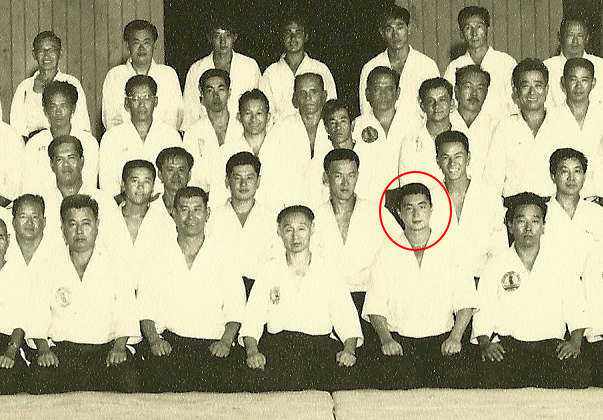

![El grado importa – Cinturones Negros en Aikido [Spanish Version]](https://www.aikidosangenkai.org/blog/wp-content/media/kauai-yoshimitsu-yamada-1966-1.jpg)
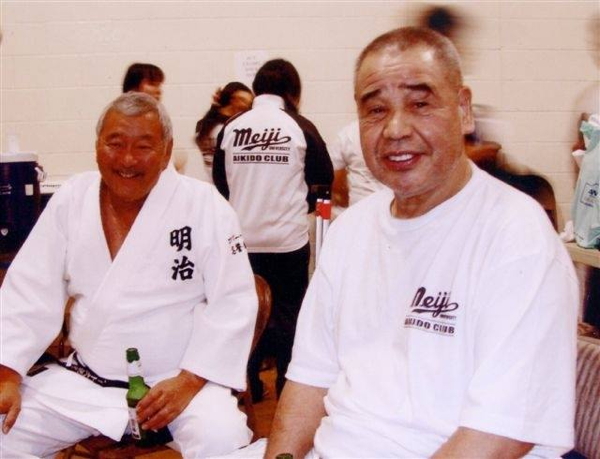
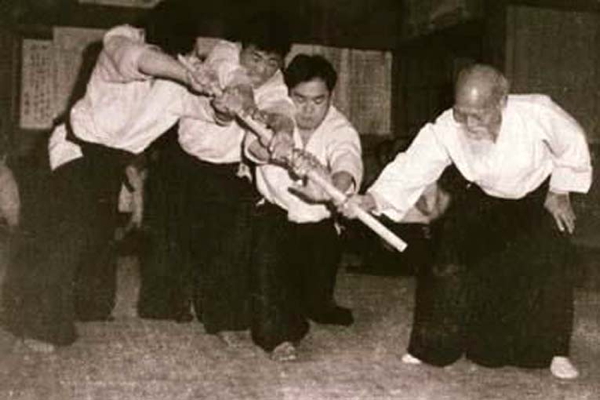 “However hard we pushed the staff would not move.” – Yasuo Kobayashi
“However hard we pushed the staff would not move.” – Yasuo Kobayashi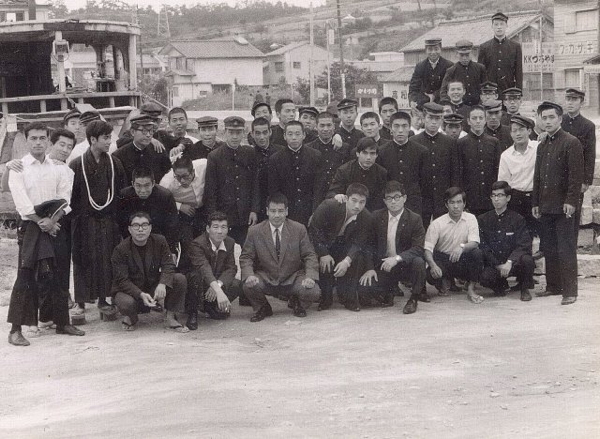 “When we went to Hawaii for a seminar wearing our student uniforms
“When we went to Hawaii for a seminar wearing our student uniforms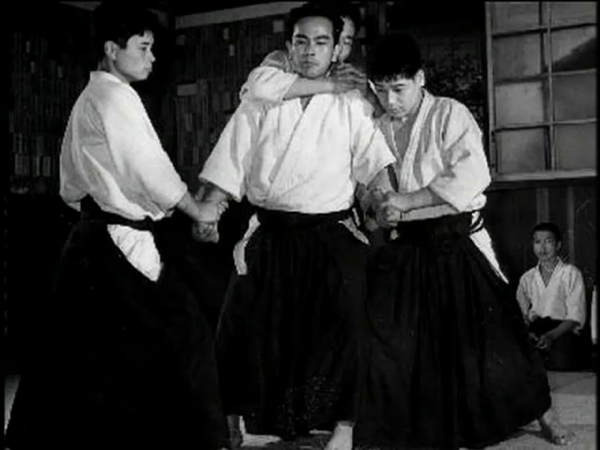 Nobuyoshi Tamura (left), Koichi Tohei (center), Yasuo Kobayashi (right)
Nobuyoshi Tamura (left), Koichi Tohei (center), Yasuo Kobayashi (right)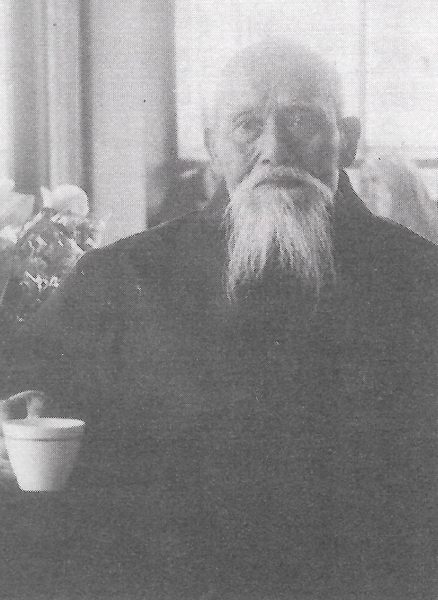
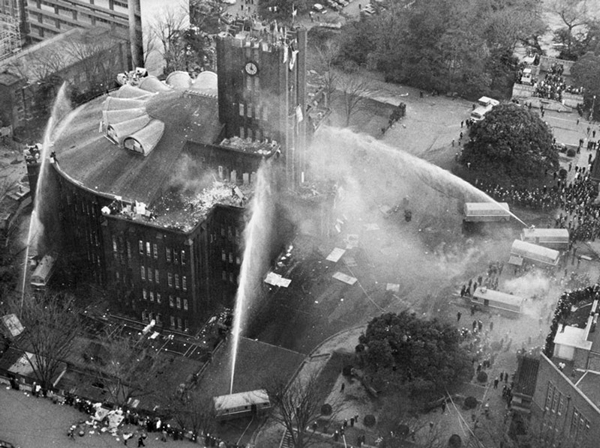 Suppressing protesters at Tokyo University – January 1969
Suppressing protesters at Tokyo University – January 1969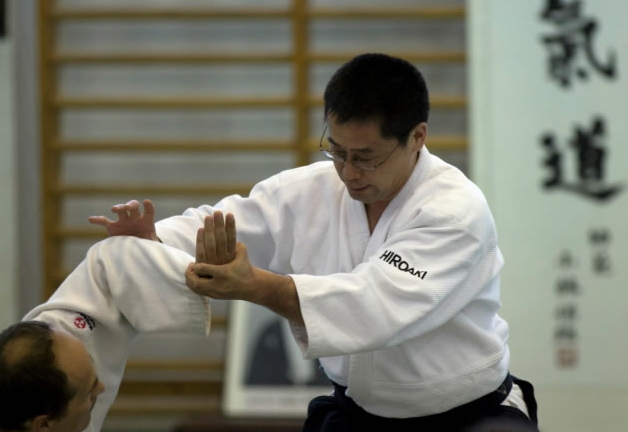 Hiroaki Kobayashi Sensei, now a professional instructor
Hiroaki Kobayashi Sensei, now a professional instructor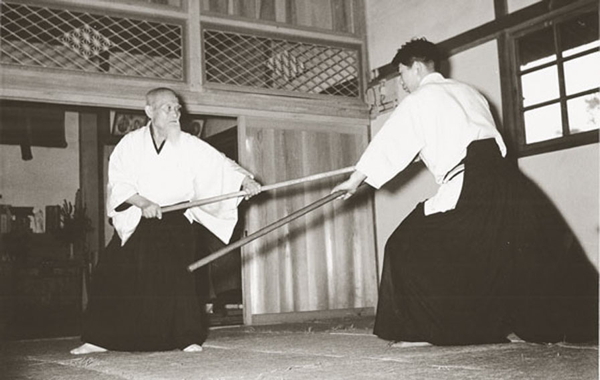

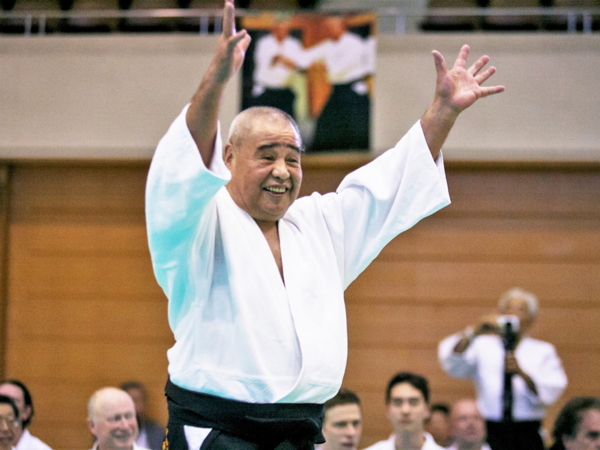
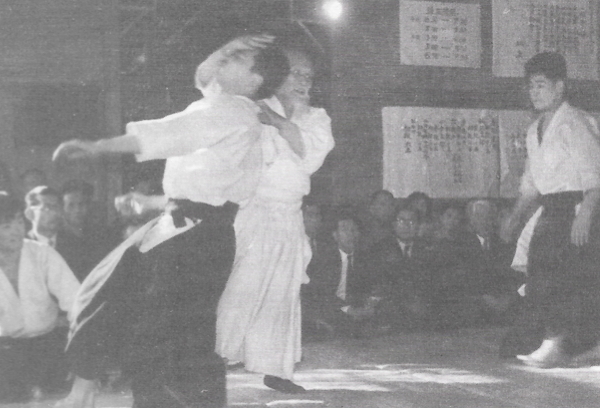 Aikido Founder Morihei Ueshiba in old Hombu Dojo
Aikido Founder Morihei Ueshiba in old Hombu Dojo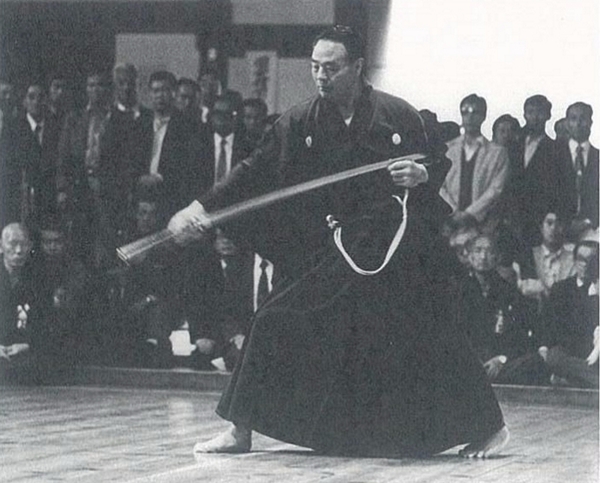 Tomoaki Danzaki, 1906-2003, of the Muso Shinden Ryu
Tomoaki Danzaki, 1906-2003, of the Muso Shinden Ryu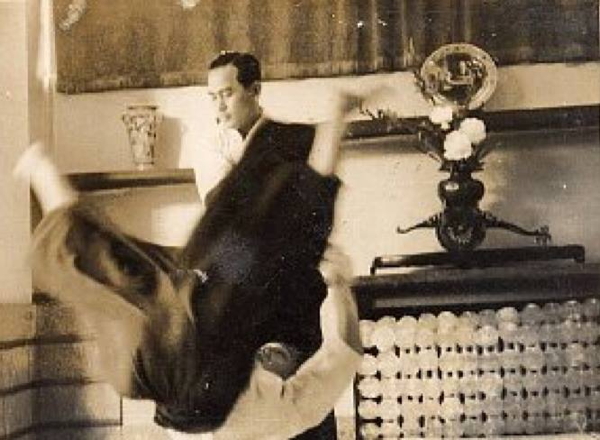 Yasuo Kobayashi taking ukemi for Koichi Tohei
Yasuo Kobayashi taking ukemi for Koichi Tohei Front row second from left: Tadashi Abe (阿部正)
Front row second from left: Tadashi Abe (阿部正)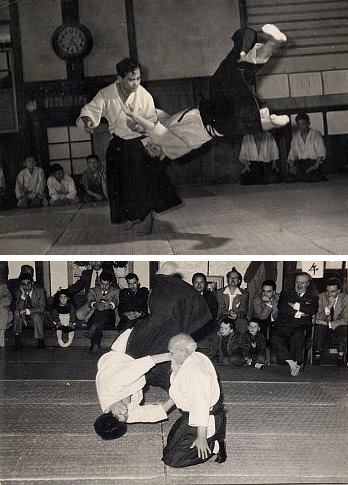 Yasuo Kobayashi taking ukemi for Koichi Tohei (top)
Yasuo Kobayashi taking ukemi for Koichi Tohei (top)